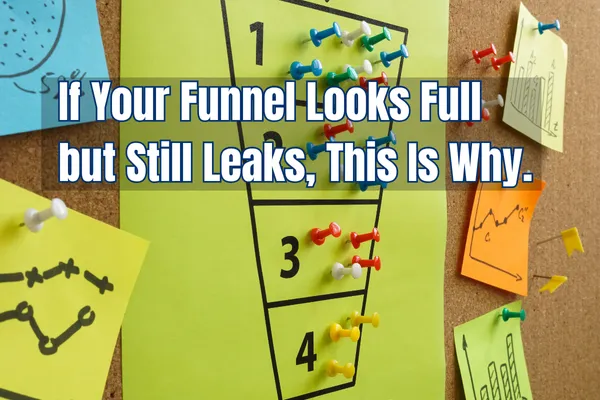
Why Most Lead Funnels Leak—And How to Fix Yours for Good
The Silent Killer in Your Sales Pipeline

It’s easy to assume your lead gen strategy is working. The ads are live. The form fills are coming in. Your CRM shows activity. But here’s the truth:
Most lead funnels leak—and they’re leaking money, not just metrics.
If you’ve ever wondered why your pipeline looks full but your calendar doesn’t, this post is for you. We’re going to break down exactly where most businesses lose leads, what it costs them, and how to fix it before it becomes a scaling nightmare.

Where the Leaks Actually Happen
Here’s the hard part: your funnel isn’t failing because of traffic or targeting. It’s failing in the handoff—that critical space between a lead showing interest and your team turning that interest into a conversation.
Here’s what typically happens:
A lead fills out a form or responds to an ad.
Your system sends a generic email or waits for manual follow-up.
Hours (sometimes days) go by.
The lead cools off.
You finally follow up… and they’ve either ghosted or gone with someone else.
That’s not a lead problem. That’s a system problem—and it’s costing you real opportunities every single day.
The True Cost of a Leaky Funnel

Let’s get specific.
If you generate 100 leads a month and even just 30% Leak Out due to slow or missed follow-ups, that’s 30 potential jobs gone. If your average customer value is $1,500, that’s $45,000/month in missed revenue.
Most businesses don’t even know they’re losing that much. Why? Because the data isn’t obvious. It’s buried in voicemails, unopened texts, and abandoned conversations.
And unless you’re tracking speed-to-lead, response rate, and conversion velocity, you're flying blind.
Why Traditional Funnels Don’t Cut It Anymore

Funnels used to be enough—simple form > thank you page > manual follow-up.
But today’s buyer doesn’t wait.
They want answers now. They want booking options now. They want to feel like your business is ready for them when they’re ready.
Here’s what breaks in most traditional funnels:
No instant engagement. If the lead fills out a form and just gets a thank-you message, they’re already forgetting about you.
Manual bottlenecks. If your team has to call or email back, you’re losing speed and consistency.
Generic automations. If your “automation” is just a drip email that goes out 24 hours later, that’s not a system—it’s a delay.
What a High-Converting Funnel Actually Looks Like

A real funnel doesn’t just collect leads. It engages, qualifies, and books—automatically.
That means:
✅ Instant voice or SMS response the moment a lead opts in
✅ Smart routing based on lead type, urgency, or campaign source
✅ 24/7 automation that works even when you don’t
✅ Real-time notifications and calendar booking built in
When that happens, your leads don’t leak—they convert.
The Fix: Build the System, Not Just the Funnel
If you’re tired of watching leads slip through the cracks, the solution isn’t more ads or more staff. It’s a system that turns cold traffic into real conversations—and real revenue.
This is where automation tools like Phonetix AI come in. It’s not just about answering leads—it’s about answering them fast, qualifying them smart, and booking them consistently.
No more “just checking in” follow-ups. No more ghosted leads. Just a system that catches every opportunity and closes the loop—for good.

Final Thought: Stop the Leak Before You Scale
Scaling a leaky funnel just means you lose faster. Before you throw more budget at ads or hire another sales rep, ask yourself:
Is my funnel really built to convert?
If you’re not sure, it’s time to test it. Ask yourself: How fast do we respond? How personalized is the first touch? Are we booking appointments automatically—or just hoping they’ll call us back?
The truth is, your leads aren’t broken.
Your system is.
Fix that—and the conversions follow.
